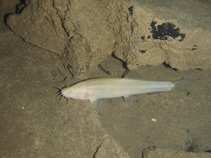http://www.fishbase.org/Summary/speciesSummary.php?genusname=Schistura&speciesname=spiesi ---> http://52.67.158.155/Summary/speciesSummary.php?genusname=Schistura&speciesname=spiesi
http://52.67.158.155/Summary/speciesSummary.php?genusname=Schistura&speciesname=spiesi ---> https://fishbase.net.br/Summary/speciesSummary.php?genusname=Schistura&speciesname=spiesi
https://fishbase.net.br/Summary/speciesSummary.php?genusname=Schistura&speciesname=spiesi ---> https://fishbase.net.br/summary/Schistura-spiesi.html
Schistura spiesi

You can
sponsor
this page
Common name (e.g. trout)
Genus + Species (e.g. Gadus morhua)
-

-
About this page
-
Languages
-
User feedbacks
-
Citation
-
Uploads
-
Related species
-


 Upload your
photos
and
videos
Upload your
photos
and
videos
Pictures
|
Google image
 Schistura spiesi
Schistura spiesi
Picture by
Panitvong, N.
Teleostei (teleosts) >
Cypriniformes
(Carps) >
Nemacheilidae
(Brook loaches)
Etymology:
Schistura:
Greek, schizein = to divide + Greek, oura = tail; an allusion to forked caudal fins (Ref.
45335
)
;
spiesi:
Named for John Spies, Australian speleologist and pioneer in ecological and archaeological cave studies and conservation in Thailand.
.
More on authors:
Vidthayanon
&
Kottelat
.
Environment: milieu / climate zone / depth range / distribution range
Ecology
Freshwater; benthopelagic. Tropical
Asia: Tham Phra Wang Daeng cave in Thailand.
Size / Weight / Age
Maturity: L
m
?
range ? - ? cm
Max length : 11.9 cm SL male/unsexed; (Ref.
51711
)
Short description
Morphology
|
Morphometrics
Dorsal
soft rays
(total): 12;
Anal
soft rays
: 8. Body pinkish white in life, without color pattern; developed suborbital flap in male, with groove behind flap extending for some distance anteriorly and posteriorly; a long, pointed flap-like nostril tube; eye subcutaneous, vestigial, in a small pit, or apparently missing; eye pit or slit always present and connected with groove bordering suborbital flap in male or with a groove in homologous position in female; eye becoming indistinct at about 8 cm SL; snout depressed; over about 6.5 SL, back humped behind nape, especially in males (Ref.
51711
).
Inhabits cave, most commonly found resting on the bottom of shallow pools with flowing water. Sometimes occurs in mid-water, or also co-exists with
Neolissochilus subterraneus
in deeper areas with little flow. Swims along the surface of pools with its snout raised up, out of the water while moving it head from side to side. Large fish occur in the deeper zone, far from the entrance of the cave.
Life cycle and mating behavior
Maturity
|
Reproduction
|
Spawning
|
Eggs
|
Fecundity
|
Larvae
Vidthayanon, C. and M. Kottelat
, 2003. Three new species of fishes from Tham Phra Wang Daeng and Tham Phra Sai Ngam caves in northern Thailand (Teleostei: Cyprinidae and Balitoridae). Ichthyol. Explor. Freshwat. 14(2):159-174. (Ref.
51711
)
IUCN Red List Status (Ref.
130435
)
Vulnerable (VU)
(D2); Date assessed:
10 October 2011
CITES
Not Evaluated
Not Evaluated
Threat to humans
Harmless
Human uses
FAO - Publication:
search
|
FishSource
|
More information
Countries
FAO areas
Ecosystems
Occurrences
Introductions
Stocks
Ecology
Diet
Food items
Food consumption
Ration
Common names
Synonyms
Metabolism
Predators
Ecotoxicology
Reproduction
Maturity
Spawning
Spawning aggregation
Fecundity
Eggs
Egg development
Age/Size
Growth
Length-weight
Length-length
Length-frequencies
Morphometrics
Morphology
Larvae
Larval dynamics
Recruitment
Abundance
BRUVS
References
Aquaculture
Aquaculture profile
Strains
Genetics
Electrophoreses
Heritability
Diseases
Processing
Nutrients
Mass conversion
Collaborators
Pictures
Stamps, Coins Misc.
Sounds
Ciguatera
Speed
Swim. type
Gill area
Otoliths
Brains
Vision
Tools
E-book
|
Field guide
|
Length-frequency wizard
|
Life-history tool
|
Point map
|
Classification Tree
|
Catch-MSY
|
Special reports
Check for Aquarium maintenance
|
Check for Species Fact Sheets
|
Check for Aquaculture Fact Sheets
Download XML
Summary page
|
Point data
|
Common names
|
Photos
Internet sources
AFORO (otoliths) |
Aquatic Commons
|
BHL
|
Cloffa
|
BOLDSystems
|
Websites from users
|
Check FishWatcher
|
CISTI
|
Catalog of Fishes
:
genus
,
species
|
DiscoverLife
|
ECOTOX
| FAO - Publication:
search
|
Faunafri
| Fishipedia |
Fishtrace
| GenBank:
genome
,
nucleotide
| GloBI |
Google Books
|
Google Scholar
|
Google
| IGFA World Record |
MitoFish
|
Otolith Atlas of Taiwan Fishes
|
PubMed
| Reef Life Survey | Socotra Atlas |
Tree of Life
| Wikipedia:
Go
,
Search
| World Records Freshwater Fishing |
Zoobank
|
Zoological Record
Estimates based on models
Phylogenetic diversity index (Ref.
82804
): PD
50
= 0.5000 [Uniqueness, from 0.5 = low to 2.0 = high].
Bayesian length-weight: a=0.00692 (0.00311 - 0.01538), b=3.02 (2.85 - 3.19), in cm total length, based on LWR estimates for this Genus-body shape (Ref.
93245
).
Trophic level (Ref.
69278
): 3.0 ±0.3 se; based on size and trophs of closest relatives
Resilience (Ref.
120179
): Medium, minimum population doubling time 1.4 - 4.4 years (Preliminary K or Fecundity.).
Fishing Vulnerability (Ref.
59153
): Low vulnerability (10 of 100).
Back to Search
Random Species
Back to Top
Accessed through:
Not available
FishBase mirror site :
Laguna, Philippines
Page last modified by :
mrius-barile
|